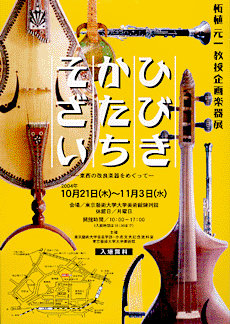DatesOct 21 (Thu), 2004 - Nov 3 (Wed), 2004

| Session: | October 21, Thursday, to November 3, Wednesday, 2004 |
| Place + Hours: |
The University Art Museum, Tokyo National University of Fine Arts and Music, Chinretsukan Gallery |
| Admission: | free |
|
To 'improve' literally means to make something better by changing its flaws or defects. Performers and instrument makers have always made improvements in musical instruments in the course of history. All instruments, therefore, can be said to be more or less 'improved musical instruments.' The purpose of this exhibit is to compare, from certain perspectives, instruments before and after 'improvement.' Musical instruments of the Early Meiji Period Modernization and consort Transmission Imitation, replication, and creation Automatic instruments |
|
| Organized by | Faculty of Music, Tokyo National University of Fine Arts and Music; KOIZUMI Fumio Memorial Archives; The University Art Museum, Tokyo National University of Fine Arts and Music |
| Co-organized by | Doseikai, Tokyo National University of Fine Arts and Music |
| Co-operation: | King Records, Co., Ltd. |
| <Inquiry phone> NTT Hello Dial 03-5777-8600 |
|
We would appreciate your understanding that the museum might be closed, or opening hours changed without prior notice depending on weather conditions, disasters, etc. Please call hello dial: 050-5541-8600
© 東京藝術大学大学美術館 The University Art Museum, Tokyo University of the Arts, all rights reserved